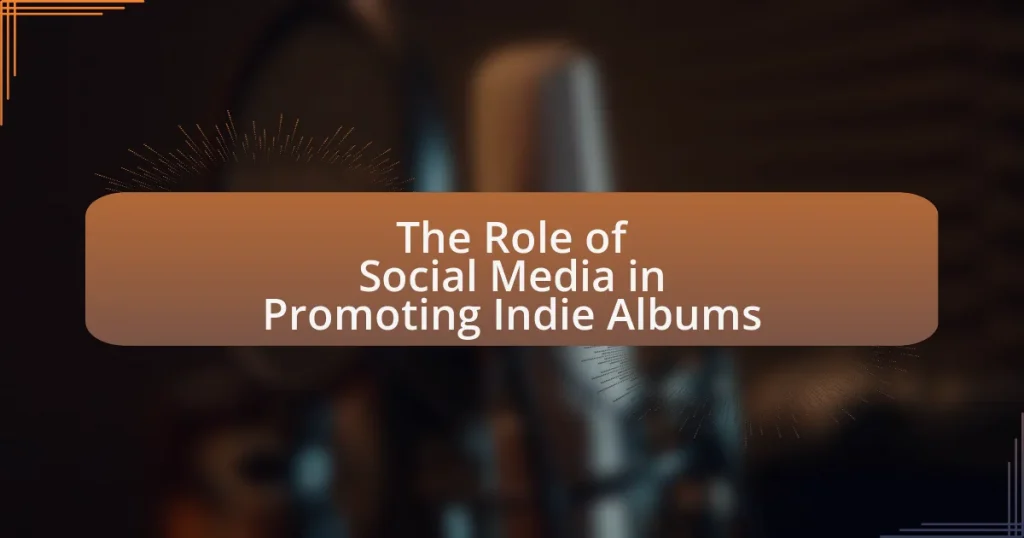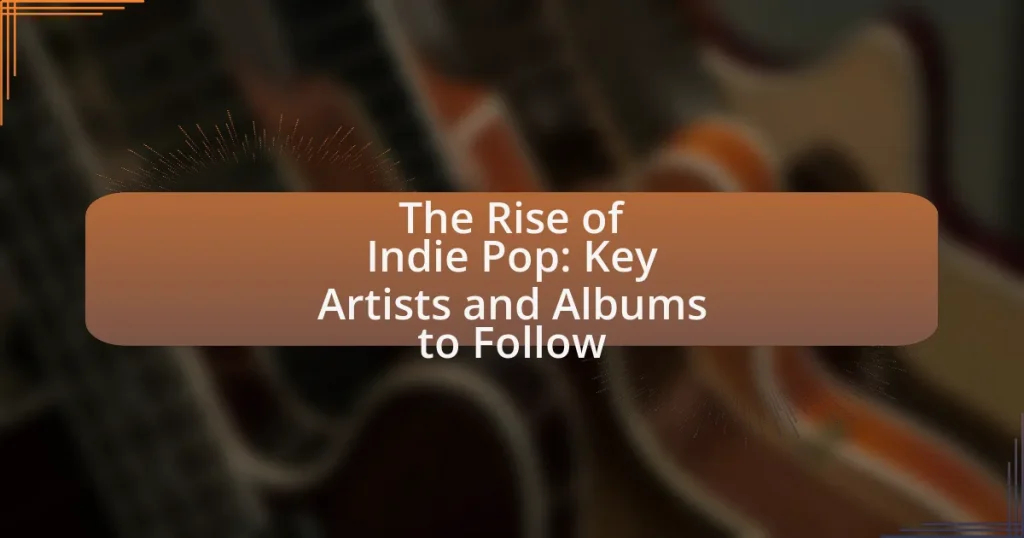The article examines the rise of concept albums in indie music, highlighting their cohesive narratives and thematic depth that differentiate them from traditional albums. It discusses how artists utilize interconnected songs to explore complex ideas, enhancing listener engagement through storytelling. Key examples include notable albums like “The Suburbs” by Arcade Fire and “The Hazards of Love” by The Decemberists, which illustrate the artistic potential and commercial viability of this format. The article also addresses the challenges artists face in creating concept albums, such as maintaining narrative coherence and engaging audiences, while outlining best practices for developing successful projects in this genre.
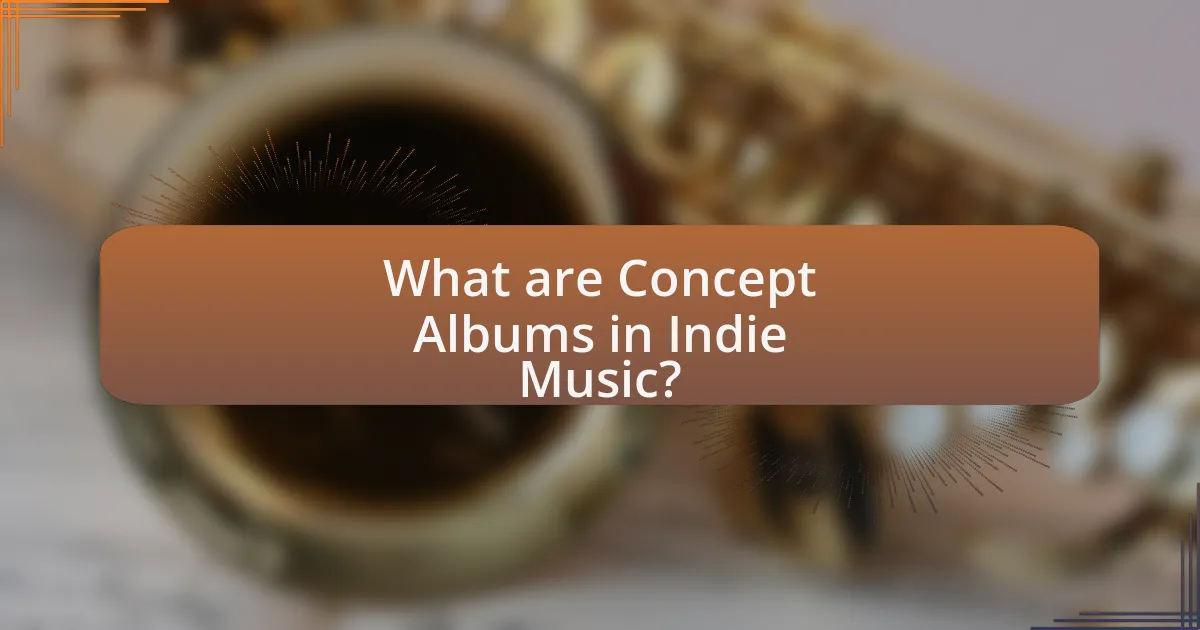
What are Concept Albums in Indie Music?
Concept albums in indie music are cohesive works that revolve around a central theme or narrative, often exploring complex ideas or storytelling through a series of interconnected songs. This format allows artists to create a more immersive listening experience, as seen in albums like “The Suburbs” by Arcade Fire, which addresses themes of suburban life and nostalgia. The use of concept albums has gained traction in the indie music scene, reflecting a shift towards artistic expression that prioritizes thematic depth and coherence, as evidenced by the increasing number of indie artists embracing this format in their discographies.
How do Concept Albums differ from traditional albums?
Concept albums differ from traditional albums primarily in their narrative structure and thematic coherence. While traditional albums often consist of standalone songs that may not relate to each other, concept albums are designed around a central theme or story that connects all the tracks, creating a cohesive listening experience. For example, Pink Floyd’s “The Wall” serves as a narrative journey exploring themes of isolation and alienation, illustrating how concept albums can provide deeper artistic expression compared to the more fragmented approach of traditional albums.
What elements define a Concept Album in the indie genre?
A concept album in the indie genre is defined by its cohesive narrative or thematic structure that connects all tracks. This narrative often explores complex themes such as personal experiences, social issues, or fictional stories, creating a unified listening experience. For instance, albums like “The Suburbs” by Arcade Fire and “The Hazards of Love” by The Decemberists exemplify this, as they both present a storyline that unfolds throughout the album, enhancing the emotional impact and engagement of the listener. Additionally, the use of recurring musical motifs and lyrical references across tracks further solidifies the concept, making the album feel like a singular artistic statement rather than a collection of unrelated songs.
How do narratives shape the listening experience of Concept Albums?
Narratives shape the listening experience of concept albums by providing a cohesive storyline that guides the audience through the music. This structured approach enhances emotional engagement, as listeners can connect with characters, themes, and events presented in the album. For example, Pink Floyd’s “The Wall” uses a narrative to explore complex themes of isolation and mental health, allowing listeners to experience a journey rather than just individual songs. This storytelling aspect encourages deeper analysis and interpretation, making the listening experience more immersive and meaningful.
Why has there been a shift towards Concept Albums in indie music?
There has been a shift towards concept albums in indie music due to the desire for deeper artistic expression and storytelling. Indie artists increasingly seek to create cohesive narratives that engage listeners on multiple levels, moving beyond traditional song structures. This trend is supported by the rise of streaming platforms, which allow for longer formats and encourage listeners to experience entire albums rather than individual tracks. Additionally, the success of notable concept albums, such as “The Suburbs” by Arcade Fire, has demonstrated the commercial viability and critical acclaim that can accompany this format, further motivating artists to explore thematic depth in their work.
What cultural or musical trends have influenced this shift?
The shift towards concept albums in indie music has been influenced by the rise of storytelling in songwriting and the integration of diverse musical genres. Storytelling has become a prominent trend, allowing artists to create cohesive narratives that engage listeners on a deeper emotional level. This trend is supported by the success of albums like “The Suburbs” by Arcade Fire, which won the Grammy for Album of the Year in 2011, showcasing the appeal of thematic continuity. Additionally, the blending of genres, such as folk, rock, and electronic elements, has encouraged artists to experiment with album formats, as seen in Sufjan Stevens’ “Illinois,” which combines orchestral arrangements with personal storytelling. These cultural and musical trends have collectively fostered an environment where concept albums can thrive in the indie music scene.
How do artists perceive the value of Concept Albums compared to standard albums?
Artists generally perceive the value of concept albums as higher than that of standard albums due to their ability to convey a cohesive narrative and deeper artistic expression. Concept albums allow artists to explore themes and stories in a way that standard albums, which often consist of unrelated tracks, cannot. For instance, artists like Pink Floyd and The Who have historically used concept albums to create immersive experiences, enhancing listener engagement and emotional connection. This perception is supported by the fact that concept albums often receive critical acclaim and can lead to a more dedicated fanbase, as seen with works like “The Wall” and “Tommy.”
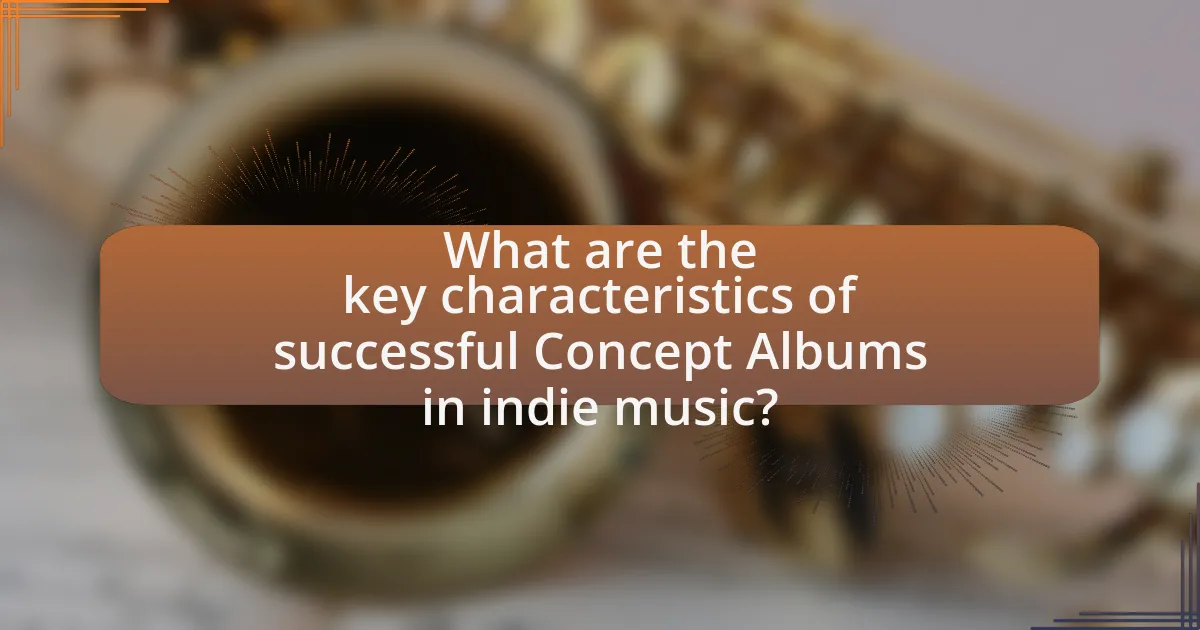
What are the key characteristics of successful Concept Albums in indie music?
Successful concept albums in indie music typically exhibit a cohesive narrative, thematic depth, and innovative soundscapes. Cohesive narratives allow listeners to engage with a story or concept that unfolds throughout the album, enhancing emotional connection. Thematic depth involves exploring complex ideas or emotions, often reflecting personal or societal issues, which resonates with audiences. Innovative soundscapes are characterized by unique instrumentation and production techniques that differentiate the album from mainstream offerings. For instance, Sufjan Stevens’ “Illinois” integrates diverse musical styles and intricate storytelling, exemplifying these characteristics and achieving critical acclaim.
How do themes and storytelling enhance Concept Albums?
Themes and storytelling enhance concept albums by providing a cohesive narrative that engages listeners on a deeper emotional level. This narrative structure allows artists to explore complex ideas and emotions, creating a more immersive experience. For instance, Pink Floyd’s “The Wall” uses a central theme of isolation and alienation, which resonates with audiences and invites them to reflect on their own experiences. The integration of storytelling within the music not only enriches the lyrical content but also encourages listeners to engage with the album as a unified work, rather than a collection of individual songs. This approach has been shown to increase listener retention and emotional connection, as evidenced by the critical acclaim and commercial success of various concept albums in the indie music scene.
What are some common themes explored in recent indie Concept Albums?
Recent indie concept albums commonly explore themes of identity, mental health, and societal issues. Identity is often examined through personal narratives and character-driven storytelling, allowing artists to delve into their own experiences or those of fictional personas. Mental health is frequently addressed, reflecting the struggles and triumphs of individuals, which resonates with listeners seeking connection and understanding. Societal issues, such as climate change, political unrest, and social justice, are also prevalent, as artists use their platforms to comment on contemporary challenges. These themes are supported by the rise of artists like Sufjan Stevens and Phoebe Bridgers, who have successfully integrated such topics into their concept albums, demonstrating the relevance and impact of these explorations in the indie music scene.
How does the sequencing of tracks contribute to the overall narrative?
The sequencing of tracks in concept albums significantly enhances the overall narrative by creating a cohesive storyline that unfolds throughout the listening experience. This deliberate arrangement allows for thematic development, emotional progression, and the establishment of motifs that resonate with listeners. For instance, in albums like “The Suburbs” by Arcade Fire, the track order reflects a journey through nostalgia and societal critique, guiding the audience through a structured narrative arc. Such sequencing not only maintains listener engagement but also deepens the impact of the album’s message, as evidenced by the way transitions between tracks can evoke specific emotions or highlight contrasts in themes.
What role does production play in the effectiveness of Concept Albums?
Production plays a crucial role in the effectiveness of concept albums by shaping the overall sound and narrative coherence of the work. High-quality production enhances the emotional impact of the music, allowing for a seamless integration of musical elements that support the album’s thematic journey. For instance, albums like “The Dark Side of the Moon” by Pink Floyd demonstrate how meticulous production techniques, such as sound layering and innovative studio effects, contribute to a cohesive listening experience that reinforces the album’s conceptual framework. This attention to detail in production not only elevates the artistic expression but also engages listeners more deeply, making the narrative more compelling and memorable.
How do production techniques differ in Concept Albums versus traditional albums?
Production techniques in concept albums differ from traditional albums primarily in their emphasis on thematic coherence and narrative structure. Concept albums often utilize continuous musical transitions, soundscapes, and motifs that link tracks together, creating a unified listening experience. For instance, Pink Floyd’s “The Wall” employs seamless segues and recurring musical themes to enhance its storytelling, contrasting with traditional albums that may feature standalone songs with distinct styles and production approaches. This focus on narrative in concept albums often leads to more intricate arrangements, layered instrumentation, and experimental sound design, as seen in works like “The Rise and Fall of Ziggy Stardust and the Spiders from Mars” by David Bowie, which integrates diverse musical elements to support its overarching narrative.
What are some notable production styles used in successful indie Concept Albums?
Notable production styles used in successful indie concept albums include lo-fi aesthetics, intricate layering, and narrative-driven soundscapes. Lo-fi aesthetics often create an intimate and raw sound, exemplified by albums like “The Microphones’ The Glow Pt. 2,” which utilizes ambient noise and minimal production to enhance emotional depth. Intricate layering is evident in works such as Sufjan Stevens’ “Illinois,” where diverse instrumentation and vocal harmonies build complex arrangements that support the album’s thematic elements. Narrative-driven soundscapes, as seen in “The Antlers’ Hospice,” employ sound design and transitions to weave a cohesive story throughout the album, enhancing listener engagement and emotional impact. These production styles contribute significantly to the storytelling and artistic expression that define successful indie concept albums.
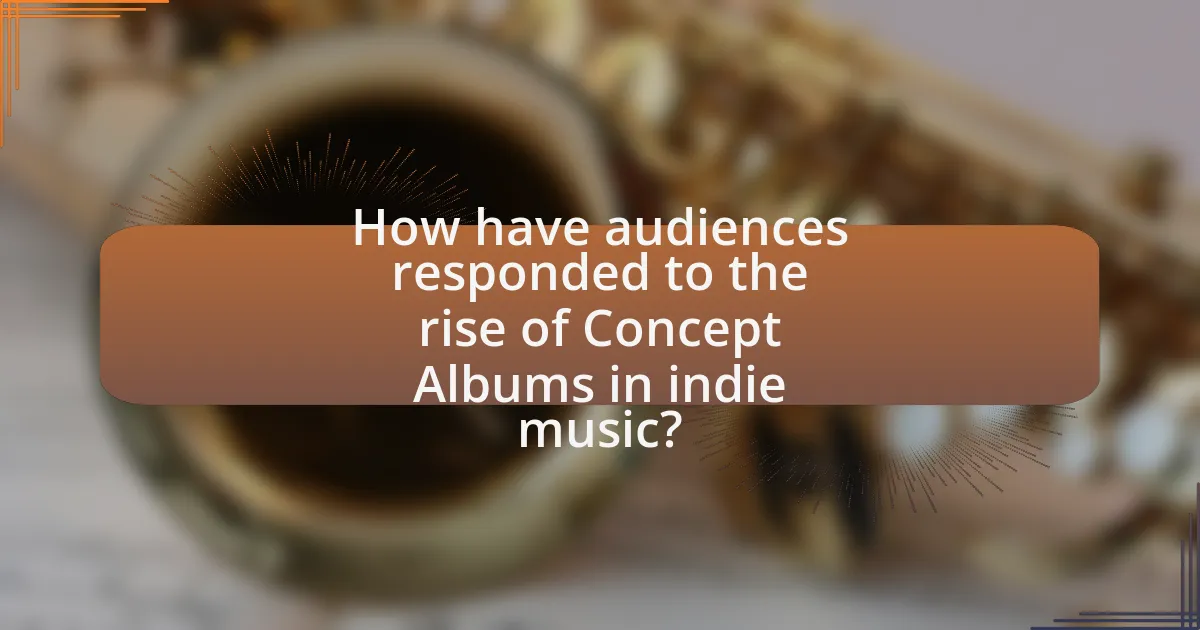
How have audiences responded to the rise of Concept Albums in indie music?
Audiences have generally responded positively to the rise of concept albums in indie music, appreciating the narrative depth and cohesive storytelling these albums offer. This trend has been marked by increased engagement, as listeners often find themselves drawn into the thematic explorations and artistic expressions that concept albums provide. For instance, albums like “The Suburbs” by Arcade Fire and “Good Kid, M.A.A.D City” by Kendrick Lamar have received critical acclaim and commercial success, indicating that audiences value the immersive experiences these works create. Additionally, a survey by the music analytics platform BuzzAngle Music revealed that concept albums have seen a significant increase in streaming numbers, reflecting a growing interest among listeners for albums that offer more than just individual tracks.
What impact do Concept Albums have on listener engagement?
Concept albums significantly enhance listener engagement by providing a cohesive narrative that encourages deeper emotional and intellectual investment. This format allows artists to explore complex themes and storytelling, which can lead to a more immersive listening experience. Research indicates that listeners are more likely to engage with music that tells a story, as it fosters a connection between the artist and the audience. For instance, a study published in the Journal of Popular Music Studies found that concept albums often result in higher listener retention rates and increased discussions among fans, demonstrating their effectiveness in creating a lasting impact.
How do fans interact with the narrative elements of Concept Albums?
Fans interact with the narrative elements of concept albums by engaging deeply with the storyline and themes presented throughout the music. This interaction often includes analyzing lyrics, discussing interpretations in online forums, and creating fan art or content that reflects their understanding of the narrative. For example, albums like “The Wall” by Pink Floyd have inspired extensive fan theories and discussions, demonstrating how listeners connect emotionally and intellectually with the album’s storyline. Additionally, fans may attend live performances where the narrative is visually represented, further enhancing their experience and connection to the album’s themes.
What are the implications of Concept Albums for live performances?
Concept albums significantly influence live performances by shaping the narrative and thematic coherence of the show. Artists often design their setlists to reflect the storyline or concepts presented in the album, enhancing audience engagement through a more immersive experience. For instance, bands like Pink Floyd and The Decemberists have utilized visual elements and theatrical presentations during live performances to complement their concept albums, creating a multi-sensory experience that reinforces the album’s themes. This approach not only captivates the audience but also elevates the overall artistic expression, making live performances an extension of the album’s narrative.
What challenges do artists face when creating Concept Albums?
Artists face several challenges when creating concept albums, primarily related to narrative coherence, musical cohesion, and audience engagement. Maintaining a consistent storyline throughout the album can be difficult, as artists must ensure that each track contributes to the overarching theme without losing individual song quality. Additionally, achieving a seamless musical flow that aligns with the narrative can complicate the songwriting process, requiring careful arrangement and production choices.
Moreover, artists often struggle with audience reception; concept albums may not appeal to listeners who prefer standalone tracks, potentially limiting commercial success. Historical examples, such as Pink Floyd’s “The Wall,” illustrate that while concept albums can achieve critical acclaim, they also risk alienating mainstream audiences. Thus, the balance between artistic vision and marketability remains a significant challenge for artists in the indie music scene.
How do budget constraints affect the production of Concept Albums?
Budget constraints significantly limit the production of concept albums by restricting the resources available for recording, marketing, and distribution. Independent artists often face financial limitations that can lead to shorter recording sessions, reduced studio time, and fewer opportunities for collaboration with high-profile producers or musicians. For instance, a study by the Music Industry Research Association found that 70% of indie artists reported budget constraints as a primary barrier to producing high-quality concept albums, which typically require cohesive storytelling and intricate production techniques. Consequently, these financial limitations can result in less polished final products and hinder the artist’s ability to fully realize their creative vision.
What are the risks of alienating listeners with complex narratives?
Alienating listeners with complex narratives can lead to decreased engagement and loss of audience. When narratives become overly intricate, listeners may struggle to follow the storyline, resulting in confusion and disinterest. Research indicates that 70% of audiences prefer clear and relatable content, suggesting that complexity can hinder emotional connection and comprehension. Additionally, complex narratives may limit accessibility, as not all listeners possess the same level of familiarity with the themes or references presented, further isolating segments of the audience.
What are some examples of influential Concept Albums in indie music?
Some influential concept albums in indie music include “The Suburbs” by Arcade Fire, “The Hazards of Love” by The Decemberists, and “Yankee Hotel Foxtrot” by Wilco. “The Suburbs,” released in 2010, explores themes of suburban life and nostalgia, earning the Grammy Award for Album of the Year. “The Hazards of Love,” released in 2009, is a rock opera that tells a narrative of love and tragedy, showcasing The Decemberists’ storytelling prowess. “Yankee Hotel Foxtrot,” released in 2002, features experimental sounds and addresses themes of isolation and disconnection, solidifying Wilco’s place in the indie music landscape. These albums have significantly impacted the genre, demonstrating the artistic potential of concept albums.
Which albums are considered milestones in the indie Concept Album movement?
Albums considered milestones in the indie Concept Album movement include “The Moon & Antarctica” by Modest Mouse, “In the Aeroplane Over the Sea” by Neutral Milk Hotel, and “The Hazards of Love” by The Decemberists. “The Moon & Antarctica,” released in 2000, is noted for its exploration of existential themes and innovative soundscapes, influencing many indie artists. “In the Aeroplane Over the Sea,” released in 1998, is recognized for its narrative structure and emotional depth, becoming a cult classic. “The Hazards of Love,” released in 2009, is a rock opera that combines storytelling with musical complexity, showcasing the potential of concept albums in the indie genre. These albums have significantly shaped the landscape of indie music and concept albums.
How have these albums influenced subsequent artists and trends?
These albums have significantly influenced subsequent artists and trends by popularizing the concept album format within indie music. This shift has led to a greater emphasis on cohesive storytelling and thematic exploration in albums, encouraging artists to create works that are not just collections of songs but unified narratives. For instance, albums like “The Suburbs” by Arcade Fire and “The Age of Adz” by Sufjan Stevens have inspired a wave of indie musicians to adopt similar approaches, resulting in a trend where albums are crafted with intricate concepts and artistic vision. This evolution is evidenced by the rise of artists such as Phoebe Bridgers and Mitski, who incorporate narrative depth and thematic continuity in their works, reflecting the lasting impact of earlier concept albums on the genre.
What best practices can artists follow when creating Concept Albums?
Artists creating concept albums should focus on a cohesive narrative that connects each track, ensuring thematic consistency throughout the project. This involves developing a clear storyline or concept that guides the lyrics, instrumentation, and overall sound, allowing listeners to engage with the album as a unified experience. For instance, Pink Floyd’s “The Wall” exemplifies this practice by weaving a narrative about isolation and alienation, which enhances the emotional impact of the music. Additionally, artists should consider the album’s structure, using interludes or transitions to maintain flow and reinforce the narrative. This approach not only captivates the audience but also encourages deeper listening, as seen in works like The Decemberists’ “The Hazards of Love,” where the storytelling is integral to the album’s identity.
How can artists effectively develop a cohesive narrative throughout an album?
Artists can effectively develop a cohesive narrative throughout an album by establishing a central theme or concept that guides the songwriting and arrangement of each track. This approach allows for a unified storytelling experience, where each song contributes to the overall narrative arc. For instance, artists like Sufjan Stevens in “Illinois” and The Decemberists in “The Crane Wife” have successfully woven intricate stories that connect individual songs through shared motifs, characters, or events, creating a seamless listening experience. By carefully planning the sequence of tracks and ensuring lyrical and musical elements resonate with the central theme, artists can enhance the emotional impact and coherence of the album.
What strategies can be employed to engage listeners with complex themes?
To engage listeners with complex themes, artists can employ narrative storytelling, relatable metaphors, and immersive soundscapes. Narrative storytelling allows artists to weave intricate plots that resonate emotionally, making complex themes more accessible. For instance, the concept album “The Suburbs” by Arcade Fire uses a narrative structure to explore themes of nostalgia and societal change, effectively drawing listeners into its world. Relatable metaphors simplify abstract ideas, enabling listeners to connect personally with the themes. Additionally, immersive soundscapes enhance the emotional experience, as seen in Sufjan Stevens’ “Illinois,” where diverse instrumentation creates a rich auditory environment that complements the thematic depth. These strategies collectively foster a deeper understanding and appreciation of complex themes in music.


